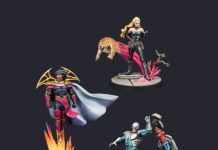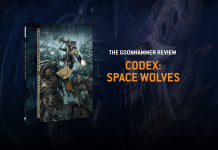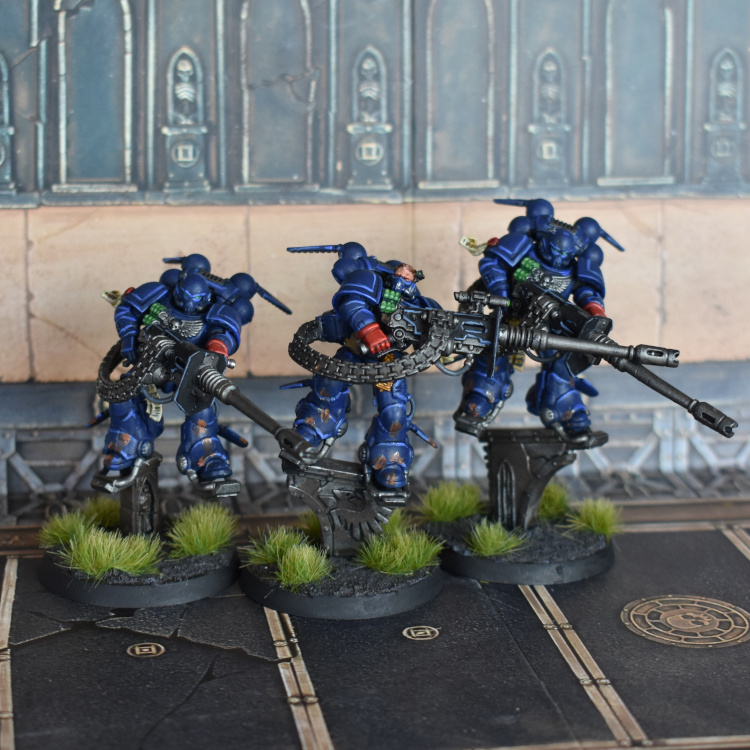It’s been almost a year and a half since our last Space Marines tactics article for Kill Team and thanks to Pariah Nexus, quite a bit has changed. Marines have the benefit of being the Kill Team faction with the most support and with the new rules in Pariah Nexus the faction has completely changed. So it was time to completely rewrite everything.
There’s a lot to talk about, so let’s dive in.
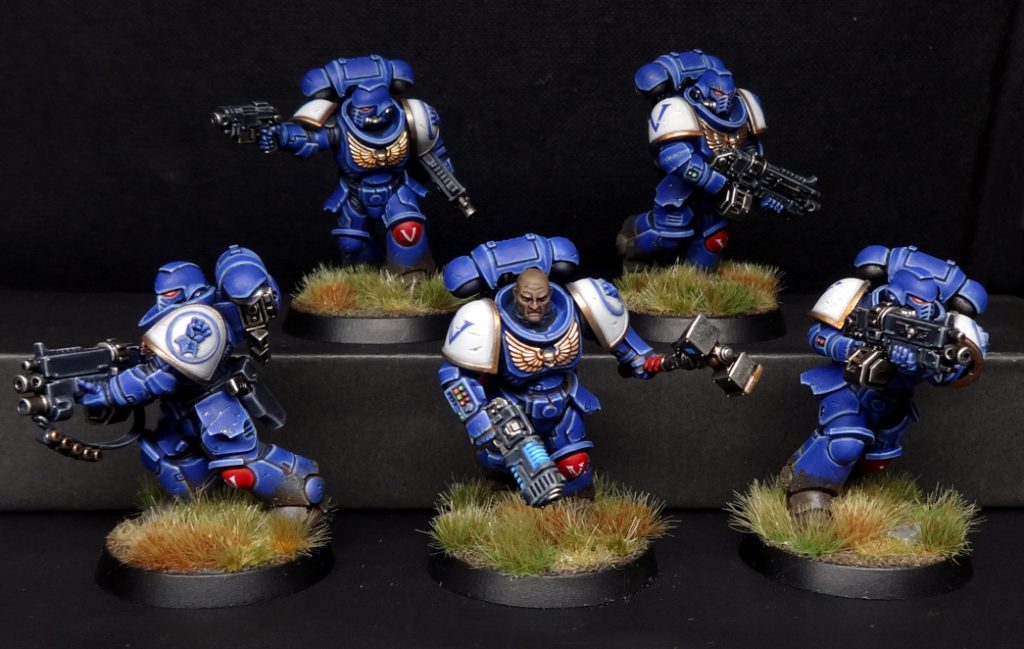
Adeptus Astartes / Space Marine Kill Teams
Better known by their GW-Tried-To-Trademark-This-But-Lost-In-Court name, the Space Marines. These are the poster boys for 40k. They’ve been showing up as models for 30 years, they’ve had good video games, dozens of books and they’re even sneaking into fantasy as Sigmarines. We’ve put it off for long enough with our discussions of Eldar and Chaos Space Marines and Custodes and Imperial Guard. In today’s article I’ll talk about using building, playing, and going up against Space Marines competitively in Kill Team.
Why Play Space Marines?
Space Marines are the most popular army in 40k. Almost everyone has a few of them. They are the most common entry point into the hobby. A lot of players have stuck with them in Kill Team despite them being mediocre in original Kill Team and struggling a lot in Arena.
That is going to change now. Remember how Dark Angels, who sucked from 4th to 8th edition, had players still loyally stick with them all through the dark times? Now GW have, to mess with Dark Angels players once more, made them really good in 9th. People who’ve been collecting Dark Angels since they had good paint schemes in Rogue Trader are getting called meta chasers. It’s hilarious. GW have reached new levels in trolling Dark Angels players by giving them what they said they wanted.
Competitive marine Kill Teams have struggled a lot, and placing high in events has relied on a) very good players b) thinking of a good gimmick for their lists where all the marine’s strengths join up with c) some good luck.
With the changes in Pariah Nexus, marines get a lot better, and I think we’ll be seeing them placing higher in events in general, rather than just in the hands of top tier players. This is combined with the changes to Ultra Close Confines rules in Pariah Nexus which heavily benefit small model count teams and prevent some of the tactics involving door blocking and corridor blocking (the Hodor style of play) shutting down small and elite kill teams.
What was wrong with Marines?
The Elites supplement gave marines a shot in the arm with a large number of new units and commanders added and made both all Primaris Kill Teams and Veteran teams more practical (and streamlining their confusing datasheets). This, coupled with the update to the Death Denied Tactic has made marines much, much better, and likely top tier in the hands of an experienced player.
Previously the weakness of marines was having low model counts (with 100-point Kill Teams comprising 5-6 models) and the prevalence of bigger model count kill teams with high AP high strength weapons, like Imperial Guard or Adeptus Mechanicus teams running lots of plasma and able to control the board – horde factions like Tyranids, Orks, Genestealer Cult, Servants of the Abyss and Cultist heavy Chaos. Marines lacked the models to play board control, and lacked the toughness to keep the few models they had alive when they started taking fire. Players were conservative with their precious handful of models, and didn’t feel able to play marines as aggressively as they should. Marines tended to fare better in the ITC format, where the kill one/kill more scoring dynamic heavily favored more elite teams, but struggled in the Arena and NOVA formats, where board control was paramount.
Standard marines being one wound made non-primaris marines squishy even with 3+ saves and Transhuman Physiology, and Primaris marines were too expensive and lacked options. The changes in Pariah Nexus range from soft to heavy buffs across the entire range. Marines were and continue to be an elite faction, and to play them you have to play them that way, placing pressure on your opponent, eliminating enemy models while protecting your own through thoughtful play and use of Death Denied. Players who realized this could create well thought-out and thematic lists that played to their chapter choices and could carry them to success at tournaments.
Because they have so many options, marines are the most complex faction in terms of potential force selection and the interaction of rules. This means that, somewhat ironically, they are not a good beginner faction, despite being the one faction for everyone has some models. This led to a lot of players struggling with them compared to simpler factions (Death Guard, Harlequins, Eldar, Dark Eldar, Guard) who have limited choices but well defined roles for those choices.
Strengths
- Options – Pariah Nexus introduces or updates 15 Commander datasheets and 16 Unit Datasheets for the faction, giving you a total of 31 new choices. Marines have a huge variety to choose from compared to other factions, some of whom have as few as one unit (sorry Harlequins, but you suck). In fact, Marines have more unit options in Kill Team than some factions have in their 8th/9th edition codexes.
- Lots of Silver Bullets – Marines have really solid options in every category, and pretty much have answers for any problem. They’re sometimes expensive or limited, but Marines can kit out to be horde clearers, assassins, power armor killers, melee monsters, etc. Marines have more options than any other Kill Team and that also means they have more answers than any other kill team.
- Tough as Hell – They don’t quite stack up to Custodes, but they come damn close: The weakest marine model is still T4 with a 4+ save, and it’s pretty trivial for Marines to get 4+ invulnerable saves or multiple wounds without spending too many points, while Gravis armored marines like Heavy Intercessors give you T5, 3W bodies. They also have Transhuman Physiology, so just pushing through a flesh wound won’t do anything to blunt their effectiveness.
- Good Baseline – Marines are default 3+ to hit in melee and shooting and they can easily get two or three S4, AP-1 attacks. That’s enough that even cheap Marine models can threaten hordes.
- Tactics – Marines have some very good faction-specific tactics that make them even more viable, and having Death Denied back at 2 CP again completely changes the game for marines.
Weaknesses
- Lack of Cheap Models – Some competitive Kill Team formats push missions that need objective sitters. These models often may not actually do anything so the cheaper they are the better, and Space Marines don’t have the 5-7 point models that you can just throw in the back and ignore. Likewise they don’t have a dirt-cheap Leader option they can hide in the backfield.
- The Toys Can Be Expensive – You get the option to bring Terminators, jump pack Vanguard Vets, Eliminators with Las-fusils and much more, but these are expensive options that will quickly eat up your points. 4-5 model kill teams are likely to struggle, so you’ll generally need to balance heavier units against your cheaper options to make sure you have enough bodies, even in 125-point formats.
- Complex – Those options come with a downside: Making the faction incredibly complex. You have a stupid number of decisions to make when roster building and choosing your models for a game, and the number of tactics and rules interactions you have to remember is staggering. Marines are, frankly, not a good faction for beginners.

Getting Started with Space Marines in Kill Team
To play marines in Kill Teams you will need the core rulebook and the new Pariah Nexus book. The Pariah Nexus book is available in the quite pricey Pariah Nexus box set, but it also contains a squad of Heavy Intercessors and a Heavy Intercessor Captain which will give you a 100 point Kill Team and a Commander to play alongside it. You no longer need the Elites supplements as the rules for Space Marine kill teams in this book have been overwritten by those in Pariah Nexus. Likewise, unless you’re planning to play Commander, you won’t need that book either.
If buying the new box set isn’t your jam, there’s also ebay. If you can pick up the book and objective cards at a good price, take it. Getting the board and terrain is a good idea as well, as Arena is now out of print and the Pariah Nexus rules functionally replace those for Arena. Once you’ve got the book you are completely free to choose how you want to theme or paint your force. If you picked up the current starter you have the tactics cards and five Reivers to start you off, though Reivers aren’t great. Extremely not great.
For Competitive play you will likely be taking advantage of the panoply of choices that Marines have, and that will mean taking single models from a lot of different data sheets. However this is not what most people want to do, particularly starting out – they just want to paint fun and thematic kill teams and play games. So consider this additional wrinkle if you’re planning to play marines competitively.

Choosing a Chapter – Chapter Tactics
First introduced in Elites, Chapter Tactics allow you to differentiate your space marine team with rules that match the Chapter they’re from, giving you additional advantages. When you build your team, you choose one of these to apply to your team. They range in power from “not adding much” (Raven Guard) to “extremely good” (Space Wolves). Note that these don’t cover the Grey Knights — they’re an entirely separate faction — you can find our write-up of Grey Knights here. Deathwatch are a bit stranger in that they share units with marines but have their own tactics, chapter tactic and some additional rules. They act more like a special type of space marines now rather than their own distinct faciton.
If you’ve read Elites, then the chapter tactics in Pariah Nexus will look incredibly familiar as they’re copy-pasted from there. I think this was a missed opportunity to look at the chapter tactics as a whole and either make some balance changes or add additional Chapter Tactics for popular successor chapters (Crimson Fists and Flesh Tearers would have been nice additions, and buffing Raven Guard would also have been nice). I’d love to see some successor chapters or Badab War chapters done to the point where I’m waiting to see if we get Kill Team 9.0 and I’ll write it my damn self if I have to at that point.
The best chapter tactics are still Salamanders, Blood Angels, Space Wolves and Black Templars. White Scars require a specific mode of play and force selection. Iron Hands is OK in general and has improved with marines getting an extra wound. Dark Angels are mediocre and Raven Guard stayed terrible. Deathwatch you’ll choose because you want to play them and take a tooled-up marine force and the tactic is incidental to that choice, rather than something you’d want to take just for the bonus.
Black Templars – Righteous Zeal
Re-roll charges. This only really empowers a single build, but it’s a simple and effective trait. This tactic is great for melee kill teams, and being able to re-roll failed charges helps get you into combat where you can chop up your opponent. B
Blood Angels – Red Thirst
If you charged or were charged, you add +1 to wound rolls in melee. Another melee-focused chapter tactic, and very solid. Again think about building your kill team to take advantage of this. If you are fighting Death Guard then you’ll be wounding on 2s whether you take a power axe or a power fist, which lets you think about AP and Damage as the key factors in which weapons you choose. It’s great for bullying cultist lists as you wound all T3 on 2+. Thundercloud: This is how I’ll be doing my Kill Team. A
Dark Angels – Grim Resolve
If you didn’t move, you can re-roll 1’s to hit in the shooting phase. Also, you can re-roll the dice to determine whether your team is broken in the Morale phase. Kill Team is a game of movement so the shooting ability won’t come up as often as you like but if you’re using it on 1-2 models with plasma then it’s giving you a real benefit. This is a tactic that favours gunline play, and while you can build a kill team around this for 3D terrain play, it’s a bad idea for Arena/Nexus play. This is like a classic/throwback Dark Angels rule in the sense that it’s not very good. C+
Deathwatch – Mission Tactics
Pick one enemy data sheet at the start of the game to be your priority target. Models with this trait re-roll 1s to wound against that target. The strength of Deathwatch is in the variety of weapons you can take, but this tactic is nothing to sniff at and very effective against kill teams with a small variety of troops. You also pick this after seeing your opponent’s kill team, so can choose things you have to murder, or the majority unit they’re bringing. Of course, the biggest downside to this trait – and Deathwatch generally – is that you’re giving up Death Denied. B
Imperial Fists – Siege Masters
Add 1 to injury rolls if the opponent is benefitting from cover. If you expect to do your killing at range this is the best Chapter Tactic. It pairs well with the Demolitionist Specialism, turning the injury roll into 3+ to Kill, and gives you a 17% better chance of killing something in cover. This is a reasonable tactic in Arena where lots of models can hug cover, and means you’ll kill more models when you are making injury rolls. It’s not the best marine tactic, but Imperial Fists players are choosing to paint yellow so it’s not like they’re hobbying in easy mode anyway. B
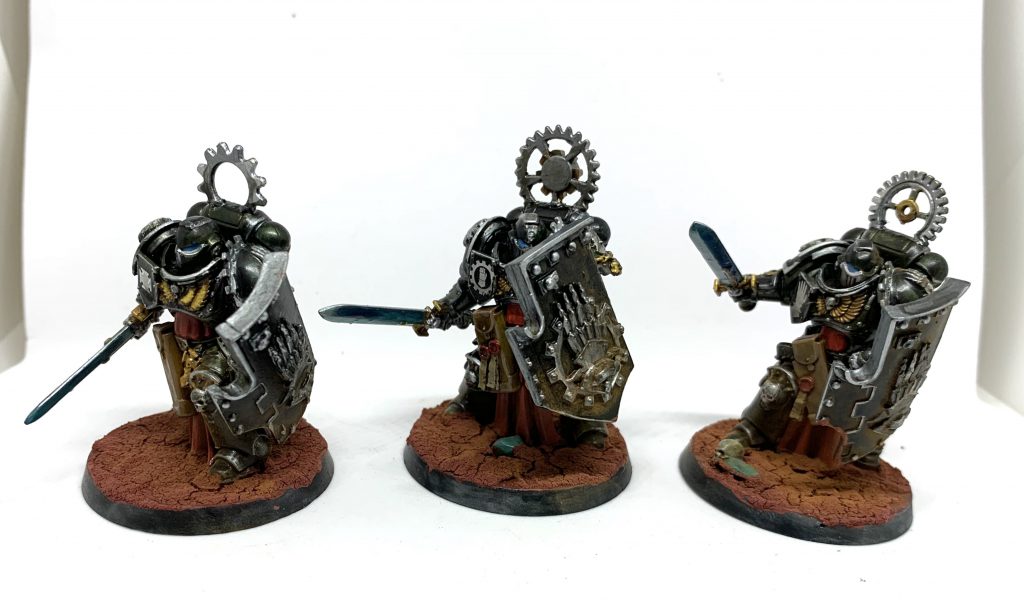
Iron Hands – The Flesh Is Weak
Gives all of your models a 6+ Feel No Pain roll. This keeps your models alive longer, and can be used with any style of marine list you want to play (melee, balanced, shooty). It’s not a top-tier chapter tactic, but it’s a chapter tactic that you can always use. It’s got a lot more useful now that marines have more wounds and you will get more opportunities to use the tactic. On average it’s basically a 20% increase in your effective wounds In a 12-wound kill team. B
Salamanders – Master Artisans
Reroll a single failed Hit and a single failed wound roll in each phase. This can more or less be 6 re-rolls a turn if you play it well (2 for Overwatch in movement, 2 in Shooting, 2 in Fight), which is quite good. Some competitive play formats don’t reward killing that heavily, but it’s still the most generically powerful Chapter Tactic. Worst-case you “only” get two re-rolls in a turn. A favourite tactic for shooting teams. A
Ultramarines – Codex Discipline
Your team has +1 leadership, and if they fall back or retreat they can still shoot to hit on a 6+. Marines don’t generally have leadership issues and hitting on a 6 makes the other half of the trait mediocre. For marines to fail nerve tests you need to have lost probably half your team. The firing after fall back is situational, and while good on models with flamers is not something to rely on in games. D
Raven Guard – Shadow Masters
If you’re 12″ away from an enemy you have cover against them. This is good in 40k because the board is big and the cover rules are restrictive. Kill Team boards are small and if you’re at long range the generous cover rules probably already have you hidden. This chapter tactic is terrible in general, and completely worthless in Arena. F
Space Wolves – Hunters Unleashed
If you charged or were charged, you ad +1 to hit rolls in melee. This is usually worse than the Blood Angels version but it’s nice with power fists or wounded models. Still, this is pretty useful. Almost all marines shift to hitting on 2+ and you can still hit on 3s with power fists and thunder hammers, which significantly increases your combat power. This is a good solid chapter tactic to build a brutal CC team around. Goes well with assault intercessors, vanguard veterans, power fists and thunder hammers. A
White Scars – Lightning Assault
Add 2″ to your advances, and if an enemy model fell back your models can still charge. This is a tactic you have to build around by taking a lot of assault weapons (flamers, assault bolt rifles, bolt carbines) as suddenly your models are bouncing 9-14” around the table per turn, giving you Harlequin levels of maneuverability. This is great for getting across a board in two turns, and lets you go fast when you need to challenge objectives or get into flamer range. White Scars pair perfectly with flamers. This is a mediocre tactic unless you build your team around using it and playing either a control list or a close in firefight list, when it becomes very strong. So in the right list it’s an A+ but overall it’s more like a B
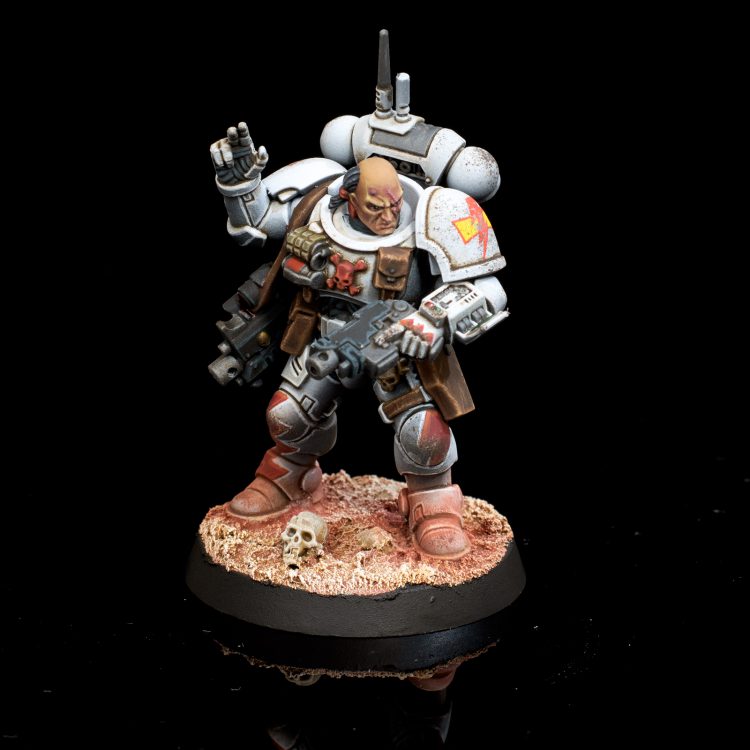
Adeptus Astartes Special Rules
All of models available to Space Marine Kill Teams have the following generic rules:
Transhuman Physiology
Space Marines ignore hit penalties from the first flesh wound. Without Death Denied it isn’t something you can rely on, but with it you play aggressively with your offensive threats and still have them be threatening. Even without certainty it’s a nice benefit and helps you kill in the later phases.
And They Shall Know No Fear
Re-roll failed nerve tests. Between this, the relatively high leadership and the low model count of marine teams morale isn’t usually a problem for Marines.
Adeptus Astartes Weapons
The Space Marines have too many weapons to cover in detail here, but it’s worth noting that they have access to good weapons for virtually every occasion, be it short-range shooting, long-range shooting, guns for taking out heavy armor, guns for taking out hordes, and melee weapons to do all of the above. What we will address in this section are the changes to space marine weapons introduced in Pariah Nexus.
Weapon Changes in Pariah Nexus
Similar to the Warhammer 40k 9th edition weapons update for Imperial armies, marines in Kill Team got a faction-wide update of their weapons. These are all improvements, so this means that for the time being, space marines have significantly better weapons than any other faction, even when they have the exact same weapons. The specific changes for Kill Team in Pariah Nexus are:
- All marine flamers now have a 12” range. None of the other factions have been updated yet. This means that on open tables you’re getting flamed in the face if you want to charge marines unless you’re Harlequins reliably rolling 12 or better on 3d6. This also means that zero-point hand flamers are now 12”. We’ll save that little fact for later.
- Heavy bolters are now damage 2. This includes scout heavy bolters. The heavy bolter, with Str 5, AP -1, Damage 2 and 3 shots is pretty much the perfect kill team weapon, with high enough strength to wound almost anything on 3+, a bit of AP to reduce armour saves and damage 2 to give you enough punch to knock down a marine and get the important two dice on the injury roll.
- Melta weapons do D6+2 damage at half range, and Multi-meltas are now Heavy 2. This makes Melta guns a lot more reliable for toasting things like Tyranid Warriors or other large multi wound gribblies.
- Some marine units pay different prices for the same weapon, most notably combi-weapons, some special weapons and some melee weapons. Pay attention to this as sometimes it’s a discount (1-point power swords for company veterans!) and sometimes it’s a penalty (9 point combi-meltas for Sternguard? What?).
- Marines have swapped out their chainswords for Astartes Chainswords, which are AP-1 and considerably more deadly. Likewise power swords are now S+1, and power axes are S+2. This makes power swords supremely useful in Kill Team whereas before they could be a bit underwhelming. It’s a particularly big boost for Deathwatch Veterans.
- Each lightning claw now gives you +1 attack. Another huge boost that makes lightning claws significantly more valuable and better than any of the power weapon options.
Adeptus Astartes Tactics
Pariah Nexus updates the Tactics list for Space Marines, reprinting the list they had in the 2019 Annual, with one major adjustment, which we’ll get to immediately. Note that while Deathwatch share unit datasheets with Space Marines, they’re a separate faction for the purposes of Kill Team rules, and as a result have a different set of Tactics. We’ll be covering those in more detail in a separate article on Deathwatch Kill Team tactics.
- Death Denied (2 CP) If a model in your team would be taken out of action, it instead takes a flesh wound. This was 2 CP, then they bumped it up to 3 CP to cost it more fairly, then Pariah Nexus bumped it back down to 2 CP. This is really, really powerful and it’s a really, really, really good argument for holding CP the entire turn. This tactic lets you be a bit more aggressive with your important models while still guaranteeing that you’ll get value out of them. At 2 CP this is arguably the single best Tactic in the entire game and is a defining ability of Astartes. A+
- Death To Traitors (1 CP) In the Fight phase, a model explodes 6’s to hit into additional attacks. This is just OK, and with the Chaos rider you’ll rarely get to use it. C
- Armour of Contempt (1 CP) You can use this tactic when a model suffers a mortal wound. Ignore that mortal wound and any other mortal wounds that phase on a 5+. If you have the extra CP this can be nice, but it’s a lot more reliable to use Death Denied to keep your models alive. C
- Masterful Marksmanship (1 CP) Give an Intercessor with a Stalker Bolt Rifle +1 to hit and wound rolls for a phase. This would be good if Stalker Bolt Rifles were good, but they aren’t. D
- Honour the Chapter (2 CP) One of your models fights again at the end of the fight phase. Marines have enough access to good melee that this tactic can completely change the tide of a battle, and it happens after most enemies would be able to fight back so you don’t have to choose between it and Death Denied. A
- Hellfire Shells (2 CP) Take a Heavy Bolter and it can only shoot once, but if it hits then you do D3 mortal wounds. This is a lot better in Deathwatch where it’s 1 CP, but Adeptus Astartes have easy access to Auspex and Comms, so you can easily boost this to hitting on a 2+. If you have the right assassination target it can be worth it but it’s not good most of the time and it’s a little worse now that heavy bolters are 2 damage. C-
- Shock and Awe (2 CP) This lets a Reiver throw a Shock grenade before charging, which will turn off Overwatch if it hits. You have to start within 6″ of an enemy before a charge and be afraid of the overwatch, which won’t happen that often, and even then you could just Death Denied the Overwatch if your opponent gets luck.This probably isn’t ever worth it but somebody might find a situation where it’s good. F
- Grav-Chute Descent, Teleport Strike and Jump Pack Assault (1 CP) These all let you deep strike up to 3 models. Grav-Chutes works for models with Grav-Chutes or Reivers, Teleport Strike for Terminators and Jump Pack Assault works for Jump Pack models. They all do what you’d expect and the effect is powerful in the right situations. Just remember that if you use these, you can’t use Death Denied that turn. B
- Angel of Death (1 CP) Give a model that charged an additional attack this phase. This is one of the better stratagems if you have additional CP, but I’d keep at least 2 CP up for Death Denied unless you’re in the fight phase against Tau or Guard. B
- Smoke Grenades (1 CP) At the beginning of the shooting phase, and Infiltrator or Suppressor Sergeant can throw a smoke grenade that obscures all friendly models within 3″. That model can’t make a shooting attack this turn. Using this Tactic gives the same feeling as calling up your parents at 3am and opening with “Dad, I messued up bad” – If you’re using this, you probably should have done something different in the Movement phase. D
- Battle-Brothers (1 CP) You can pass off a failed saving throw onto a friendly model within 6″, and it takes mortal wounds equal to the damage of the attack. This does not cancel the attack sequence so it’s best used on single large hits, and it’s also nice when you can pass the wounds off to a multi-wound model that won’t go down to zero wounds. B
- Adaptive Strategy (1 CP) When you break gain 3 CP. There’s no reason not to use this since at worst it’s neutral, but if you’re using this things are going poorly. You can only use this once a game. B
- Auspex Scan (2 CP) Lets a readied model ignore penalties to hit. Ideally you’d just use an actual Auspex but if this can let you make a critical shot then it’s probably worth it. C
- Psychological Warfare (1 CP) Choose a Reiver that took a model out of action this turn. Add 1 to nerve tests for enemy models within 6″. This is one of those things that is weirdly specific for a small effect. It’s not terrible but you’ll never remember that you have the ability when you need it. C
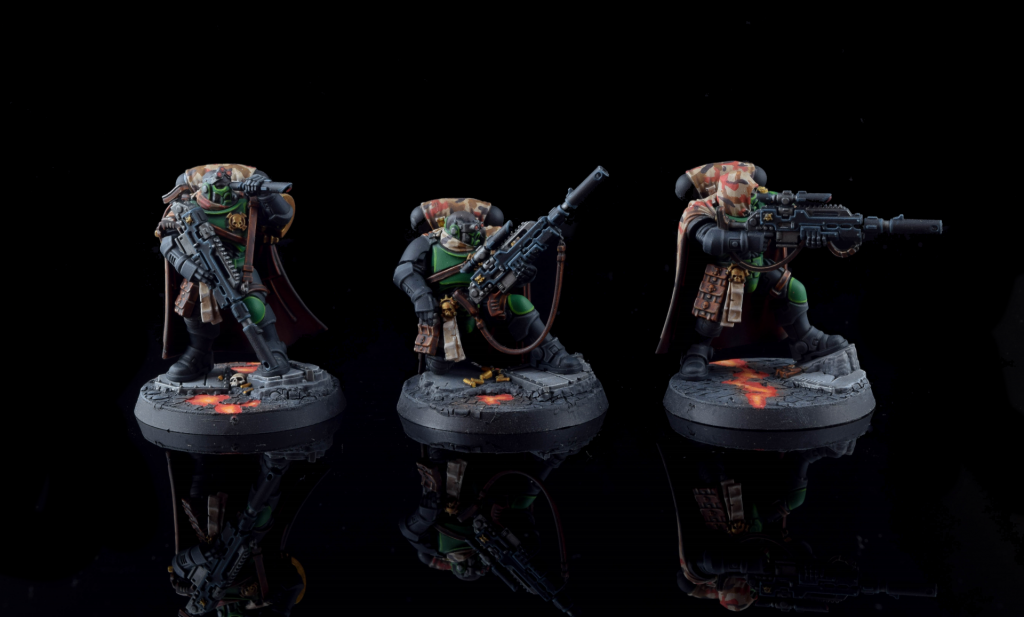
Adeptus Astartes Datasheets
Marines have access to the following non-Commander Datasheets:
- Intercessors
- Assault Intercessors
- Tactical Marines
- Scouts
- Infiltrators
- Incursors
- Eliminators
- Reivers
- Suppressor
- Terminator
- Sternguard Veteran
- Vanguard Veteran
- Company Veteran
- Bladeguard Veteran
- Heavy Intercessor
Additionally Deathwatch can take Deathwatch Veterans but can’t take Scouts, Sternguard Veterans, or Tactical marines.
As we’ve said before, Astartes as a faction are spoilt for choice.
So which of these options are worth taking?
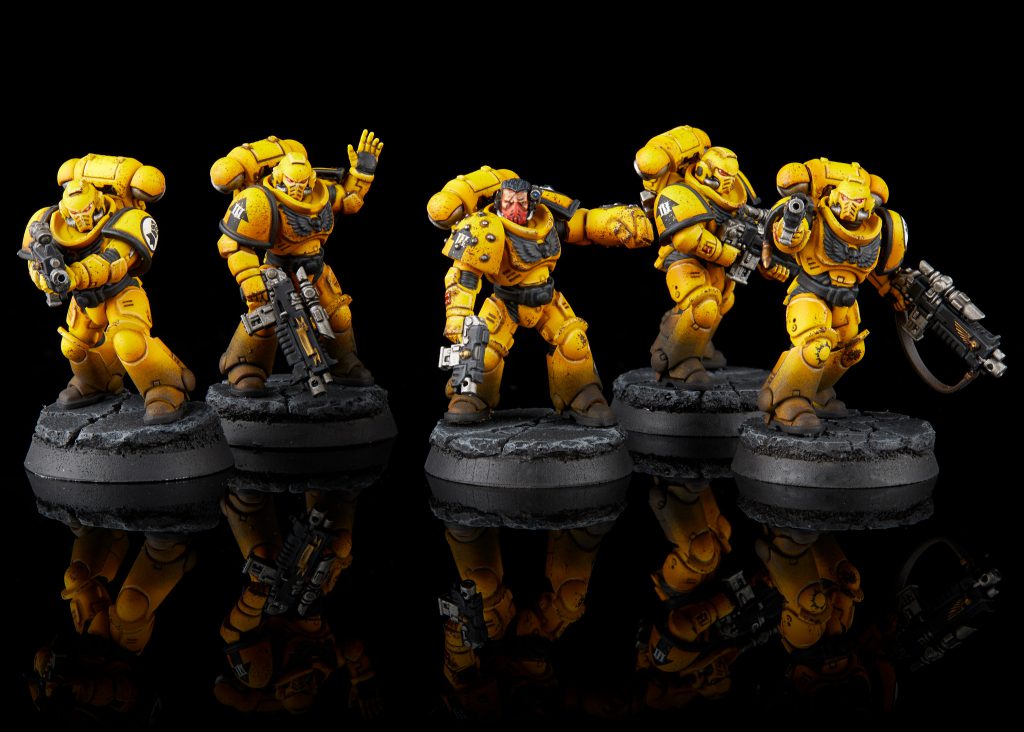
Intercessors
The white bread replacement for a tactical marine, with the Pariah Nexus changes the only difference between this and a tactical marine is 1 point and one attack, and access to different wargear.
Intercessors can take bolt rifles and their auto and stalker variants. Stalkers, with AP -2 and 2 Damage, are heavy 1 but give you anti-armour punch and multi damage. Auxiliary grenade launchers cost nothing, but can only be given to gunners who are 16 points. They’re good for fragging mobs or throwing a Krak grenade at a target for D3 damage.
At 15 points vs a tactical marine’s 14 points (or 15 for a tactical gunner) you need to think carefully about whether you are going to include any basic intercessors. Intercessor gunners with grenade launchers are a viable choice, but struggle in terms of competing with dedicated special weapon or heavy weapon troops for a place in a competitive kill team. If you are after the extra attack, why aren’t you taking assault intercessors for the same points with 3 close combat attacks and -1 AP in close combat? Ultimately you need to consider whether the additional AP and range are something you’re going to need and that will depend in part on the maps and format you’re playing.
The Intercessor sergeant however can take a variety of close combat/power weapons, as well as pistols like hand flamers (one of only a handful of non-Blood Angel and Deathwatch models that can). It is functionally exactly the same as an Assault Intercessor Sergeant and allows you to double up on this model, or have a bolt rifle and power weapon armed model. However the entry has been clarified to prevent taking two astartes chainswords or two power swords.
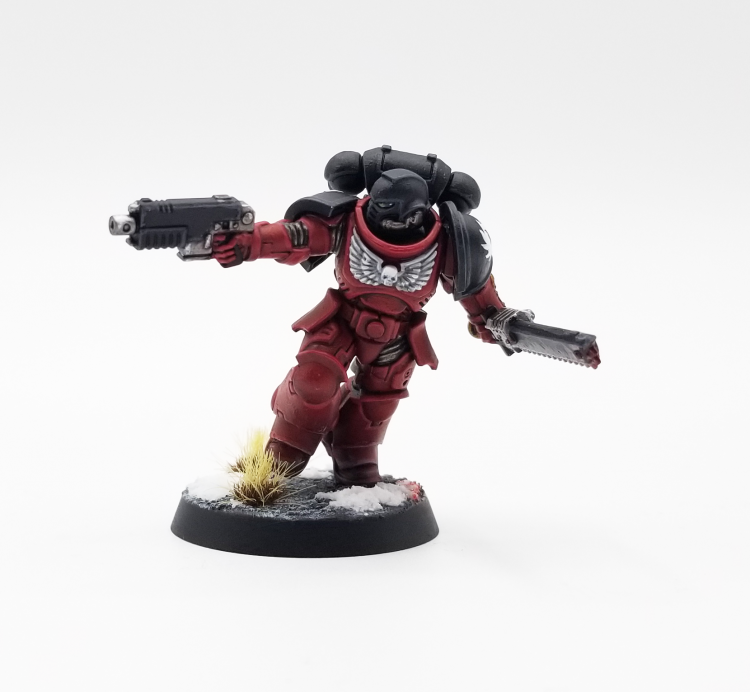
Assault Intercessors
The new hotness of 9th edition, Assault Intercessors have been chewing up pretty much everything they can catch in 40k. But what about Kill Team? With 3 S4 Ap-1 attacks in close combat, on a 2 wound model in power armour, and heavy bolt pistols give you ranged AP-1, they do good work. Assault Intercessors, particularly Blood Angel or Space Wolf, will be rolling 2+/3+ or 3+/2+ to wound T3. Assault Intercessors chew up Eldar, Guard, Cultists or Tau, and can make MEQs pretty uncomfortable. Assault Intercessor Sergeants again provide you with pistol options (including hand flamers) and access to power weapons.
You can make an assault intercessor sergeant a zealot specialist, which can be very handy against MEQs as it gives you FIVE 3+/3+ attacks on the charge if you’re just running a chainsword. Against MEQs take power weapons; against GEQs save the points and take the free chainswords and the extra attack.

Tactical Marines
For one point less than intercessors you get one less attack and worse standard weapon loadouts (boltguns vs. bolt rifles), but can take gunners with special or heavy weapons and a much bigger variety of weapons on your sergeant, including combi weapons. For gunline marine forces, a cheaper gunner with a plasma gun or heavy bolter is a good purchase, and a sergeant with access to pretty much the full marine armoury is a useful model, particularly buying the cheaper version of combi weapons. Melta guns are a bargain at 3 points for a tactical gunner vs 7 on a company veteran.
The humble tactical marine hasn’t disappeared into the warp just yet, though full Primaris kill teams are more practical than ever.
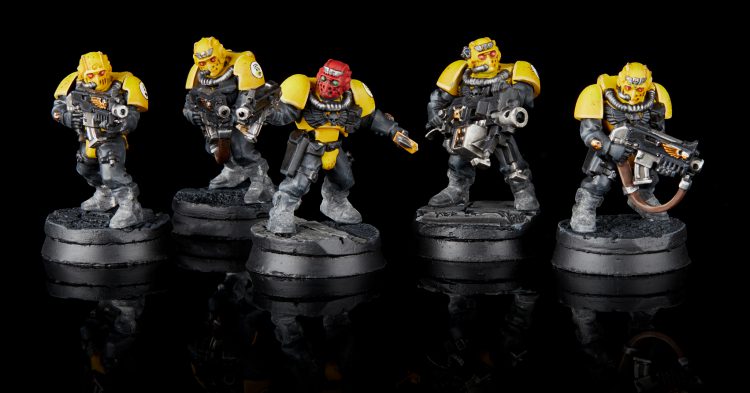
Scouts
Unlike their bigger brothers, Scouts have stayed at one wound and ten points, with gunners and sergeants at 11. Scouts are the cheapest way to get a heavy bolter, at 17 points, vs 21 for a tactical marine gunner, and one or two scout gunners in a gunline marine team remains a viable choice, though camo cloaks and keeping them in cover will keep them alive more. Scout sergeants get access to everything a standard marine sergeant can (combi-weapons, pistols and power weapons) and can take a gunslinger loadout. At 11 points, the Scout Sergeant is also the cheapest Leader specialist you can take, and worth consideration in that role for competitive play, though Eliminators now occupy that role much better most of the time despite a higher cost.
More excitingly they’ve added the options for Space Wolf scouts. Space wolves can take special weapons on gunners (opening the door to scout 14 point flamers or melta guns) and a single scout can swap his bolter for a power axe or power sword or his bolt pistol for a plasma pistol. This opens up the prospect of an 8-9 model Wolf Scout kill team with a pretty interesting load out.

Infiltrators
Infiltrators are basically giving you the option of paying 17 points for a Primaris marine with Concealed Deployment (deploy anywhere 9” from the enemy deployment zone, and Omni scramblers that prevent enemy deep strikers setting up within 7” of you) and a different bolter (6s to hit automatically wound). For Arena and Nexus this isn’t much use as you’re paying two points for abilities you can’t use. In 3D play it’s useful to deploy forward to shut down deep strikers, and as a speed bump for your opponent (it’s still a primaris so takes a bit of killing).
I’m not a big fan of these, but depending on an event pack they could be useful. They aren’t great at melee, or shooting, but they can shut down a big chunk of the board to deep strikers if your opponent is pulling things like that (Mandrakes, I’m looking at you). The Infiltrator Comms Array is a way to waste 5 points.
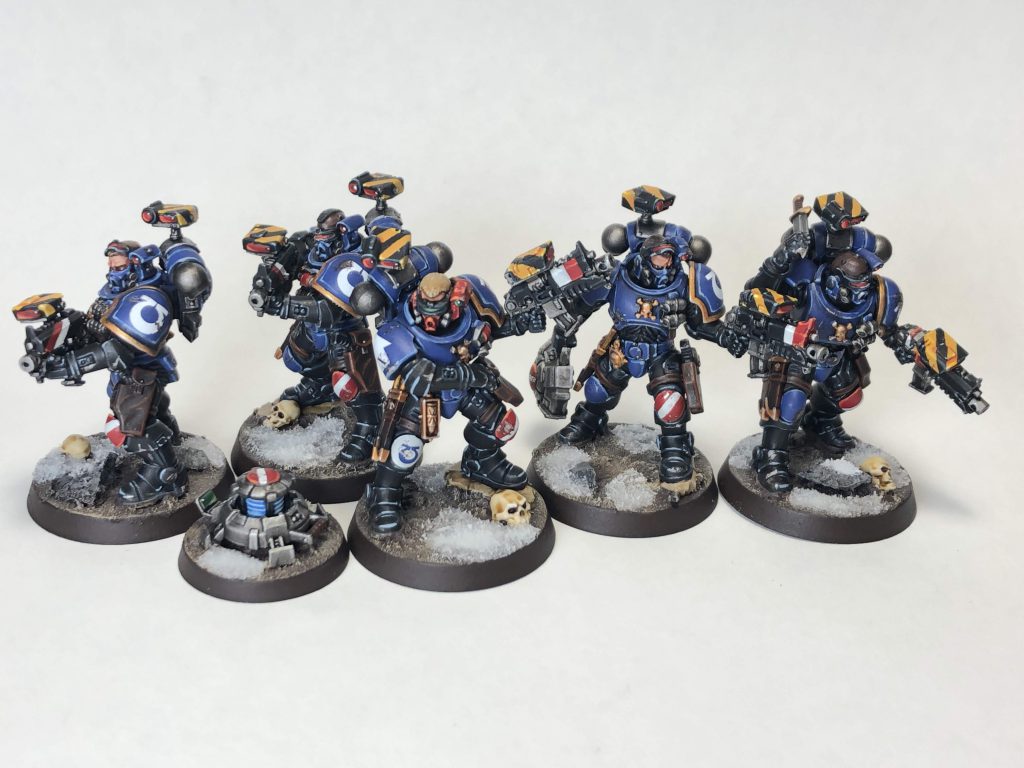
Incursors
These are infiltrators that are a bit better in close combat and have a slightly different bolter. They’re a bit better in Arena due to getting +1 to hit against obscured targets with their bolters, but I still wouldn’t take them in my marine kill team. The Haywire mine is incredibly situational, and while you could shut down a corridor with it until someone throws a Grot or Cultist on it, it costs 5 points and you have better things to spend your points on.
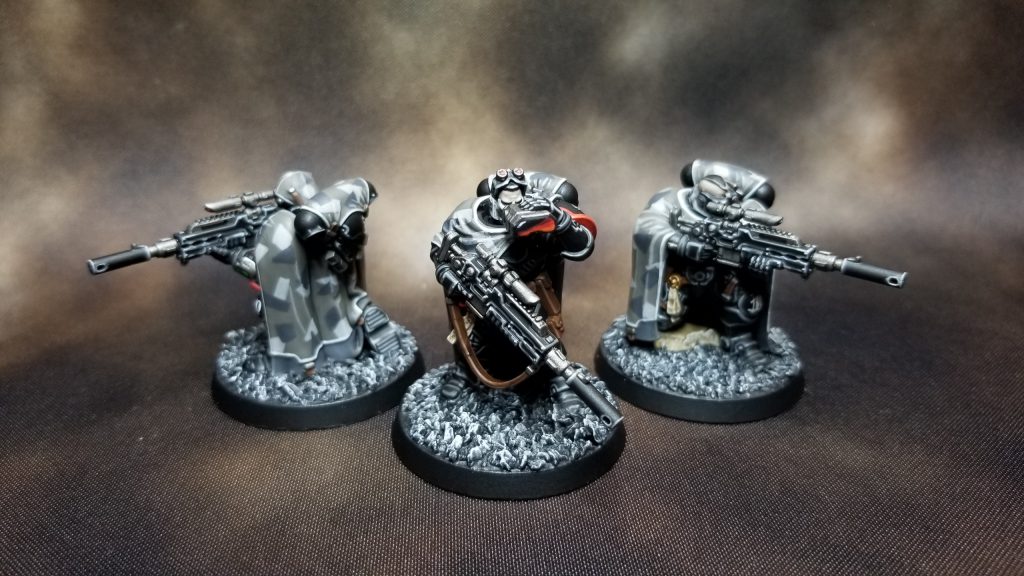
Eliminators
What if Scout Snipers but Primaris and significantly better?
At 18 points (19 for a sergeant) the Eliminator comes with a Bolt Sniper Rifle with three firing modes, or pay 5 points to get a las fusil if you have to fight a Tyranid Monster Mash list or something. They also come with BS 2+ thanks to the Pariah Nexus update, making them significantly more accurate. With camo cloaks built-in they are also -2 to hit if you keep them in cover, making them incredibly resilient.
Realistically you won’t buy a las fusil. Eliminators with Mortis Rounds cover your multi-damage needs to knock out MEQs and get that important two dice on the injury roll. And with Eliminators available you don’t really have a need for Scout Snipers, either. They make great backline models, and can shut down corridors in Arena as well as cover the backfield in 3D play. Eliminator Sergeants are a reasonable choice for your leader since they’re tough for the points and they can actually get some work done from the back line (Because Deathwatch can’t take Scouts, this is pretty much always their play). Just remember that you’re unlikely to give them comms/auspex support so you can’t really rely on the Executioner Rounds to hit.
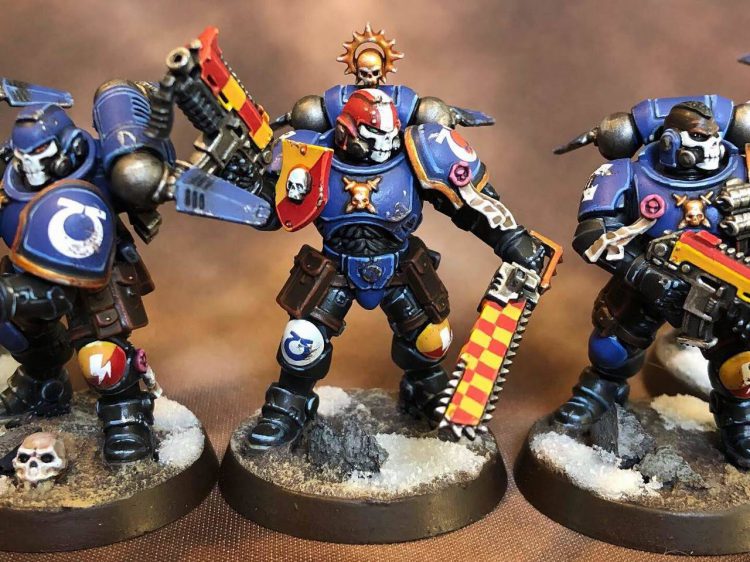
Reivers
Reivers are the marine models you get in the Kill Team Starter box, and were in the Marine Faction box as well. They come in two flavours: Carbines (essentially an Assault 2 bolter) or special issue bolt pistol and combat knife. The Reivers’ bolt pistols have been changed to be AP -2 in Pariah Nexus, but combat knives are simply +1 attack. Reivers cost a point more than Assault Intercessors for this and aren’t nearly as good in close combat. They also have the ability to give enemy units within 3″ -1 to their Leadership, but this is a pretty situational benefit.
For one more point you can get Grav Chutes, which let you drop up to 3 Grav Chute-equipped models anywhere more than 5” from an enemy model for 1 CP with the relevant Tactic, or grapnels, which let you ignore vertical height when moving. These are worthless in Arena, but can have use in 3D Kill Team. Grapnels and Carbines combined with the White Scars Chapter tactic would let you bounce around the map going 9-14” a turn spraying things with carbines, which would be interesting but lacks the punch you need to take out anything substantial. Maybe there’s a King of the Swingers list worth building with these?
Reiver Sergeants were a mainstay of Space Marine forces in early kill team, as you could give them combat specialist for 5 attacks and grapnels to let them ignore vertical height in charges, but these have largely been superseded by models that can take power weapons and crack armour.
Suppressors
At 29 points these are some of the pricier marine models you can field. On the other hand they have a strength 7 AP-1 Damage 2 gun with three shots which, if it hits a model and damages it, neither that model nor models within 2″ of it can shoot. Tactically this means that if you can target a group of models and damage one, you could prevent them from firing. Think about Grots or drones next to Freebooterz or Burna Boyz or Tau Rail Rifles, then chuckle to yourself.
Suppressors are also very much worth consideration for the Sniper specialism to given the number of shots they have. In addition they have grav chutes and can step off terrain with no issues. The 1CP Careful Aim Sniper Tactic is also well suited to the Accelerator Autocannon as it’ll have you hitting on 2s and rerolling 1s if you’re not affected by modifiers.
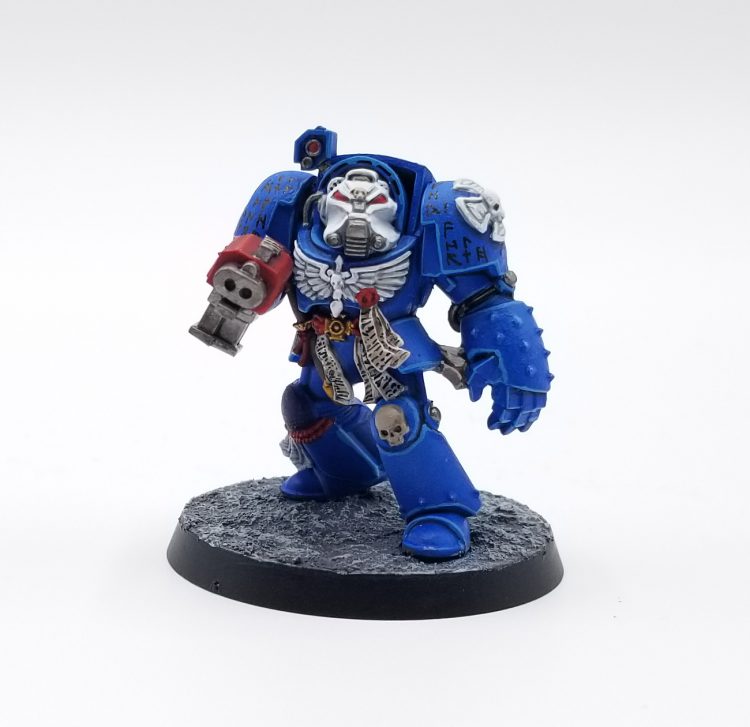
Terminators
More big winners of the Pariah Nexus update, Terminators are now even tougher with 3 wounds. While they’ve lost the ability to get 3+ invulnerable saves from Storm Shields, the +1 to armour still applies so if you’re firing at a Terminator with a Storm Shield you’re going to need AP-2 or better before you start dropping the save on your target. The cheapest terminator you can field is one equipped with twin lightning claws for 28 points (and these are nastier than ever now that they get +1 attack for each claw), but a lot of people like a Cyclone Terminator Gunner who clocks in at 38 points for a Cyclone Launcher, Storm Bolter and Power Fist. Space Wolves can drop this cost to 35 by taking a power sword, power maul or lightning claw instead of a power fist, and that’s a pretty good trade. With this loadout you pretty much have to take the Heavy Specialism. A Demolitions Heavy Flamer Terminator Gunner clocks in at 35, dropping to 32 if you have a Space Wolf and swap the fist for claw or sword.
As with Scouts, Space Wolves get to do things completely differently and take a variety of close combat weapons and combi-weapons on their terminators. A Wolfguard list of Terminators and Company Veterans would be interesting, as would an Old Wolf list with wolf scouts and all the models painted with greyer hair.
Terminators are a big tough model to crash through enemy strongpoints and murder them, and both heavy flamers for a close engagement list and a cyclone for a fire base list are good choices. Putting a Comms specialist with Auspex next to your Cyclone Gunner is a good idea.
Sternguard Veterans
In their base form, Sterngard are marines with AP -2 bolters and +1 Leadership for one point more than their primaris counterparts. The strength of Sternguard is either taking a lot of combi weapons or Sternguard Gunners rocking heavy flamers for 22 points a model, which with 12” flamers is pretty nasty. The downside is that going combi-weapon heavy is very pricey and can be achieved in other ways, but you could possibly build a list out of that gimmick though it would lead to something ridiculous like a relatively hateful 4-model list. It’s made even pricier by the fact that Sternguard pay more for combi weapons for no reason: Combi meltas are 9 points on a Sternguard vs 3 points on an identically statted tactical sergeant.
Also note that you can’t take Sternguard for Space Wolves, Dark Angels, or Deathwatch.
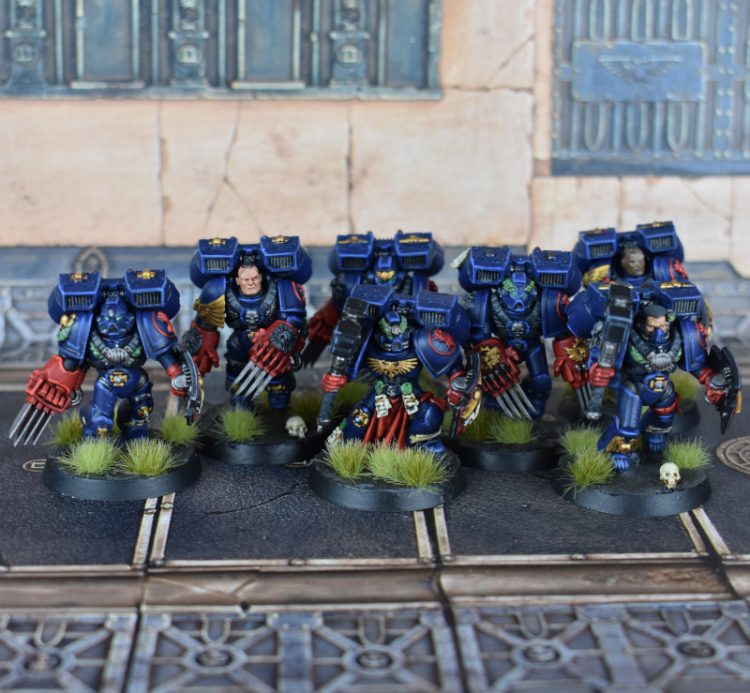
Vanguard Veterans
Essentially Assault Intercessors that cost one more point and with a slightly worse bolt pistol in their default form but the real value here is that you can swap these for something from the pistol list and something from the melee list. This means Blood Angels can have 17 point Vanguard Veterans with hand flamers and power swords, and run round with 2 3+/2+ AP-3 attacks (if you don’t give them Combat or Zealot) setting fire to things. You can also take a 20 point Sergeant with a relic blade with 3 x 3+/2+ Damage 2 Ap -3 attacks chopping up your opponents. There’s also the lightning claw + storm shield option, which is very nasty as well. Vanguard Sergeants with Relic Blades are worth taking and you can spend the extra six points to give them a jump pack and have them leaping everywhere with a 12” move and FLY.
Vanguard Veterans are a solid choice for when you want to spend slightly more points than on Assault Intercessors, but get a bit more close combat bite.
Company Veterans
This is where things get a little crazy. A company veteran can swap their boltgun for a stormshield, pistol, combi weapon, melee weapon or special weapon. A company veteran can exchange their bolt pistol for a storm shield, pistol or melee weapon. Company Veterans pay the same Sternguard tax for Combi weapons and special weapons, but their flamers stay at 3 points and grav guns at 2 points. This means you can have company veterans with flamers or grav guns and 1 point power swords or 0 point astartes chainswords (it’s free, take it). These are one point more expensive than the tactical marine equivalent, but for that you get an additional attack and an additional point of leadership.
You can take one Gunner with a heavy weapon, which gives you access to things like a heavy bolter. For missile launchers you pay double as a company veteran. Blood Angels can take Heavy Flamers though. Dark Angels can give an ordinary marine a heavy weapon, thus saving a point. The wealth of options also allows you to take double pistol models. This opens up the option to take gunslingers. Some pistols are very cheap. Hand flamers are 0 points. Grav pistols are 1 point, and if you are fighting marines they are damage 2. You can shoot with both pistols in the shooting phase or overwatch, and the second round of combat. Again company veterans pay a company veteran tax for plasma pistols (2 points each, so 20 points for a gunslinger) but it’s cheaper than a company veteran armed with a plasma gun by a point and has the same potential damage output at 12” and under.
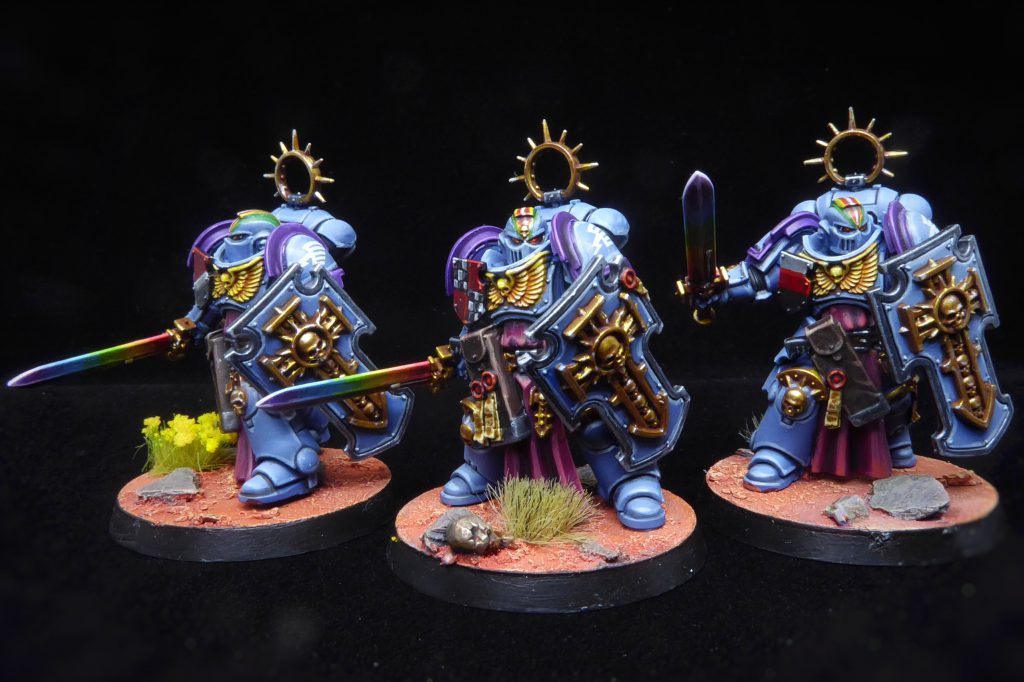
Bladeguard Veterans
Bladeguard Veterans come with a heavy bolt pistol, master-crafted power sword and stormshield, and clock in at 29 points, 30 for a sergeant. Their master-crafted powerswords are Str +1, AP -3 and damage 2. A standard Bladeguard veteran has 3 attacks, while a sergeant has 4. They also have 3 wounds and 2+/4++ from their storm shields.
Bladeguard are absolutely worth it. Cheaper than TH/SS terminators, a bit faster and with more attacks. They’re great to pile into several cultist or other models and turn them into salami slices. They’re not too bad against heavier targets, either. A sergeant can take a Volkite pistol, which is good for lightly armed or unarmoured targets with Str 5 and 2 damage for a point, or a plasma pistol to crack armour for 2. These are options to take if you have points you can’t spend somewhere else. Blood Angels or Space Wolf bladeguard are even better thanks to their Chapter Tactics.
Heavy Intercessors
17 points. 17 damn points.
17 points for Toughness 5, 3 wounds, and a 3+ save.
You can take heavy bolt rifles (Str 5, Ap-1, Damage 1 Rapid Fire), Hellstorm (Str 5, AP 0, Damage 1, Assault 3) or Executioner (Str 5, Ap-2, Damage 2, Heavy 1). In a gunline Executioners give you the multi damage you want and are a good replacement for Stalker bolter intercessors to sit in the backfield (however can’t be equipped with an Auspex). The heavy bolter has two variant options that can be taken, both costing one point more. The Hellstorm gains a shot but has no AP, the Executioner loses a shot but gains a point of AP and a point of damage. I would advise taking the Executioner and slapping the Heavy Specialism on it to give you the More Bullets stratagem if you need it. Both of these variants are still heavy.
Heavy Intercessors open up some interesting options, allowing marines to take a 100 point Kill Team with 15 wounds if they go with a five-man squad of them. The Pariah Nexus rules changes mean that you can take a maximum of 15 models and you hold objectives by the wound count within three inches of hte marker. This means a Heavy Intercessor beats two Hormagaunts or Ork boyz, and to get an objective you are contesting they either need four wounds of models or to kill a heavy intercessor, which is not necessarily very easy.
Heavy Intercessors aren’t perfect, and the sergeant can’t even take a power weapon, which means their attacks are limited to a couple of strength 4 slaps in close combat. While they are tough to move, they lack an invulnerable save so an opponent can carve them up with power weapons, heavy weapons, meltas, etc. They also move 5″, and so are a little slower. While you could run a White Scar Hellstorm bolter-armed crew and advance around the board really quickly to grab objectives, that would be a pretty niche list.
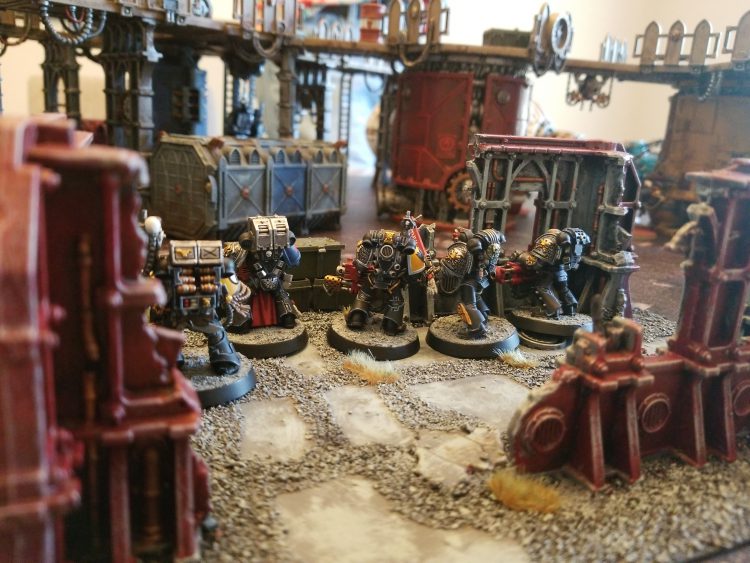
Deathwatch Veterans
While we’ll cover Deathwatch in more detail in a future article of their own, it’s worth touching on them a bit here, since they were also beneficiaries of the Pariah Nexus update. This squad can only be taken by Deathwatch forces, and Deathwatch Veterans got one point more expensive in Pariah Nexus while gaining a wound, though Gunners, Sergeants and Blackshields have all stayed 16 points while gaining their extra wounds. All models come with a bolter and power sword, which is pretty great given that power swords are now S+1, though it’s not free: If they opt to keep the bolter they have to pay 2 points for the specialist ammunition and 2 points for the power sword.
Deathwatch can ditch these for pretty much the full range of marine options though, and have options to keep their per-model cost below 20 points, which enables you to afford some big guns or big melee weapons. Deathwatch storm shields are now more expensive at 5 points which will likely change some players’ loadouts; if you’re a Deathwatch player it’s worth meticulously going through the options available to think about what you want to take and what you want your models to do.

Commanders
In addition to the changes to marine’s regular units, they also saw a large number of updates to the faction’s Commander options. While Commander has varying levels of popularity depending on where you go it’s typically not a format that sees a lot of competitive play. We’ll be updating this section with an overview of marine commanders in the future. Stay tuned!
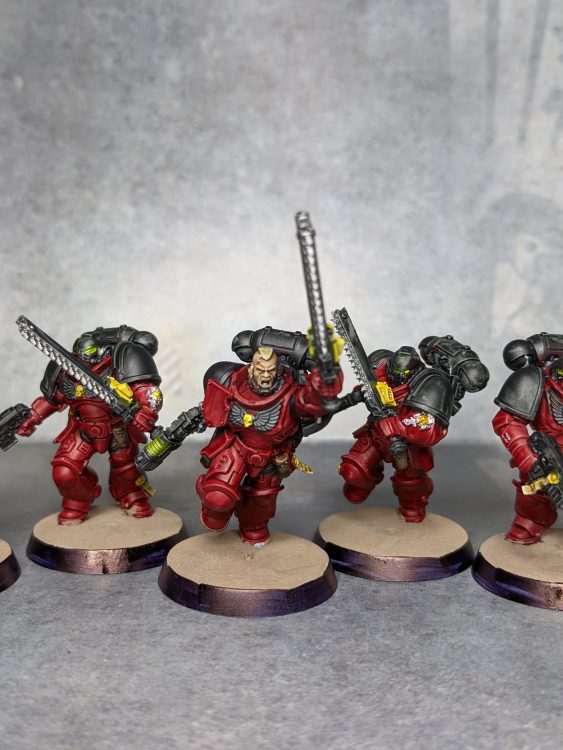
Building a Kill Team
You can now take pretty much everything marines can take in 40k. The issue with this is choosing what you’re going to take. I’ve prepared some example one box teams below, followed by some more competitive teams.
One-box teams
These options can get you going on a single unit box.
The Blender
This is a one box team built from the Assault Intercessor multipart box. 15 point assault intercessors hit real hard in close combat, and you can fit 6 models in a 100 points with two sergeants (one assault intercessor, one intercessor).
- Intercessor Sergeant (hand flamer, power fist) Leader – 20 points
- Assault Intercessor Sergeant (hand flamer, power fist) Combat – 20 points
- Four Assault Intercessors (one Veteran, one Zealot) – 60 points
This Kill Team is built around close quarters combat such as Nexus or Arena, and is about getting into combat as quickly as possible and making your opponents dead. It works well with Blood Angels, Black Templars and Space Wolves chapter tactics, and if you wanted to pick up upgrade sprues then a single sprue would cover the entire team.
You can change the load out on the sergeants to your tastes, and the example I’ve given is for Arena play. Powerfists have a reliable two damage output that will squish most things in the game, and hand flamers are a nice anti charge deterrent. You could give one sergeant a thunder hammer and the other an astartes chainsword if you wanted to put all your close combat multi damage on the combat specialist.
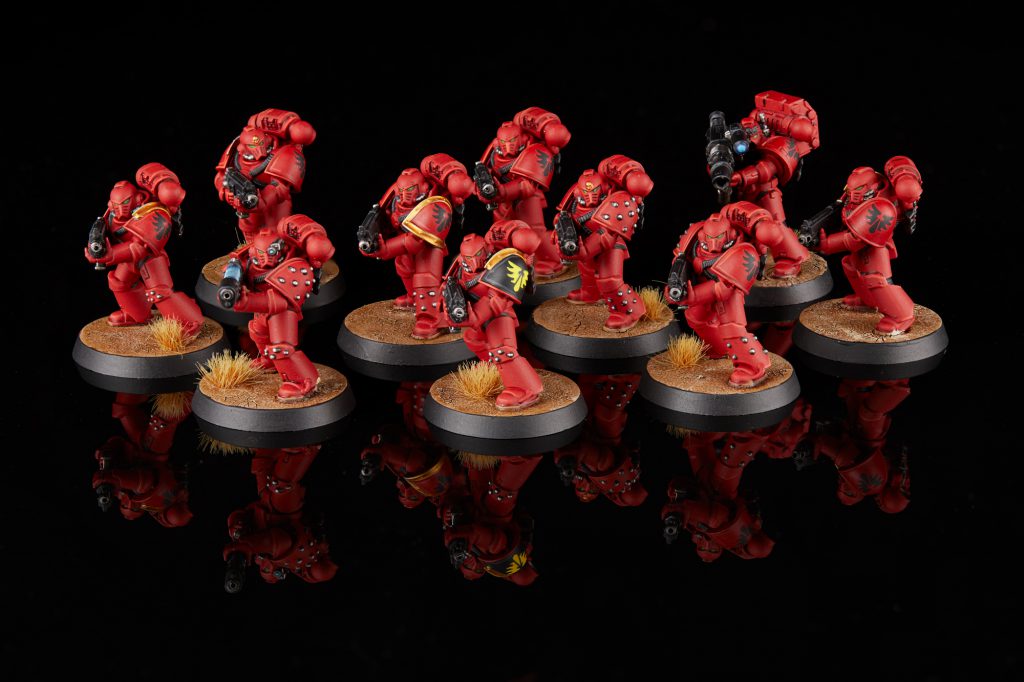
Elite Operators
Based around a tactical squad box (or Mk III or Mk IV box), this is a company veteran based team.
- Tactical Sergeant – Leader -combi plasma, auspex – 20 points
- Veteran Sergeant – Combat – bolter, powerfist – 21 points
- Company Veteran – Demolitionist – Flamer, Astartes chainsword – 19 points
- Veteran Gunner – Heavy – heavy bolter – 22 points
- Tactical Marine Gunner – Melta gun – 18 points
100 points
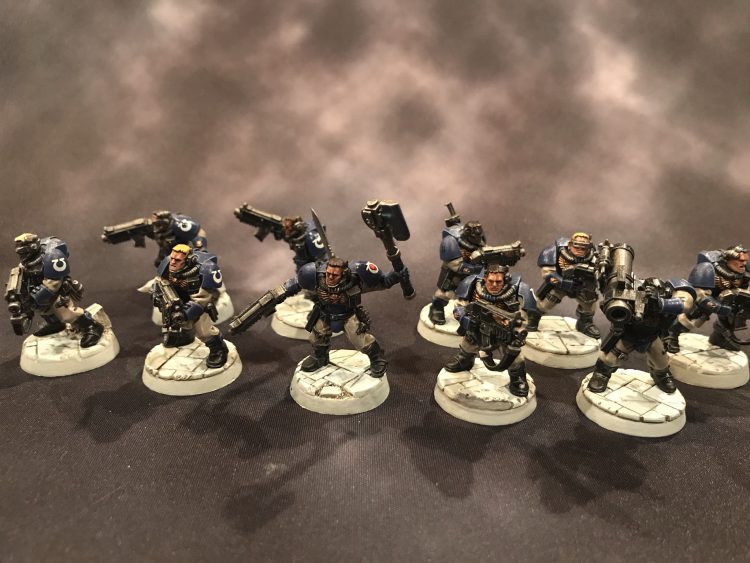
Scoot and Shoot
This kill team is based around an Intercessors box and using the White Scars chapter tactic.
- Intercessor Sergeant powerfist, assault bolt rifle – Leader – 20 points
- Intercessor Gunner – Assault bolt rifle, auxiliary grenade launcher – Demolitionist – 16 points
- Intercessor Gunner – Assault bolt rifle, auxiliary grenade launcher – Sniper – 16 points
- Intercessor – Assault bolt rifle, auspex – Comms – 16 points
- 2 x Intercessor – Assault bolt rifle
98 points
The purpose of this Kill Team is to move very quickly around the board. This is focused on Arena, as advancing white scars will move 9-14” per turn and spray things with assault bolt rifle fire. Auxiliary grenade launchers are there for picking off clumped up opponents if you want to throw D6 grenade shots at them instead.
Big Boys in Boots
This Kill Team is based off the Heavy Intercessor squad, and one I imagine a lot of people have thought of since the Heavy Intercessor points leaked (17? Are they insane?). If you give this team the Iron Hands tactic they become even harder to kill, but they would likely do best with the Salamanders tactic giving plenty of rerolls.
- Heavy Intercessor Sergeant – Leader – 18 points
- Heavy Intercessor Gunner – Heavy – Executioner Heavy Bolter – 25 points
- Heavy Intercessor – Veteran – Hellstorm bolter
- Heavy Intercessor – Comms – Executioner bolter
- Heavy Intercessor – Heavy bolt rifle
94 points
The heavy bolter and comms specialist sit in the backfield shooting at the enemy and the other models advance. The veteran may do a veteran move to challenge a central objective on turn one.
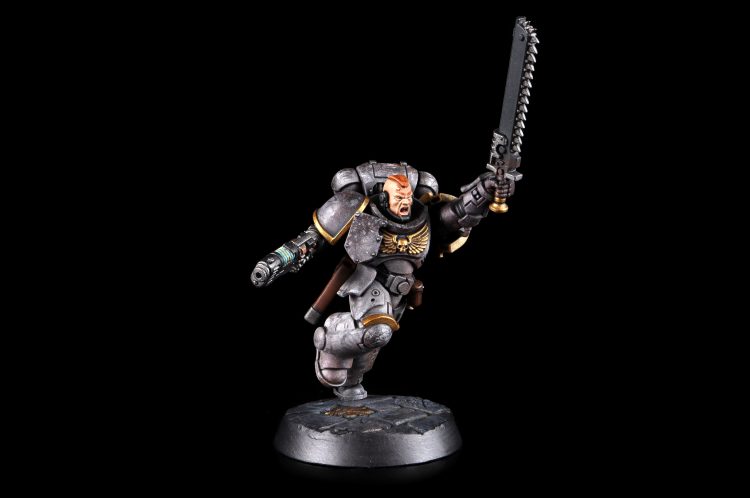
Competitive Teams
Competitive teams typically use models from different boxes, and you build a roster rather than a Kill Team, and from that roster you have pre-generated lists for different opponents and different missions.
When looking at competitive play the first thing you should do is not read your army list, but read the tournament packet. What sort of tournament is it? Is it played using the Ultra-Close Confines rules, or a tournament pack created by the event, like ITC/LVO? Is it Arena boards or 3D terrain? How much terrain is in play? What is the points level? 100 or 125? What are the missions and how does the scoring work for them? Is holding or killing better? What secondary objectives are they using? Is Deep Striking in use?
Work out the answers to these questions. Look at the variables in play and think about how you would meet the criteria to score maximum points.
Look at whether you need to murder your opponent or hold ground, and which is the more important.
If you are on Hold One, Hold More, Kill One, Kill More, how are you going to hold or kill? Is shooting or close combat better in this situation? Can you create a firebase on one objective with say a Cyclone Terminator Heavy and an Intercessor Auspex Comms specialist and murder anyone who isn’t on your side trying to get to the central objective? Are you better creating a rapid assault force to get to the other side of the board as quickly as possible? Are you taking killing or holding secondaries? How would you prevent your opponent scoring their secondaries?
Due to the elite nature of marine kill teams you are pushed towards killing. But peace was never an option.
So here’s a starter list:
Close and Personal Murder – Arena Tournament – 100 points
- Chapter Tactic – Blood Angels.
- Tactical Sergeant – Leader – Lightning claw, hand flamer – 16 points
- Bladeguard Veteran Sergeant – Combat – Master crafted power sword, heavy bolt pistol – 30 points
- Assault Intercessor Sergeant – Zealot – hand flamer, power fist – 20 points
- Company Veteran – Demolitionist – 2 x Hand Flamer – 16 points
- Intercessor Sergeant – hand flamer, power sword – 18 points
4 flamers, 4 power weapon armed models with a bladeguard veteran to blender anything big. With the new rule for flamers where you roll two dice and pick the highest for the number of shots in ultra close confines combined with a 12” range and flamers got really good. Two multi-damage melee weapons with high AP are present, and these models have been given specialisms that give more attacks with these weapons.
The combat specialism has been given to the Bladeguard Veteran to always have 5 attacks and not rely on charging.
The Demolitions specialist has hand flamers because he can fire these twice and potentially get two injury rolls in one turn on the same model, making them more likely to kill them. The model is also hard to charge as you take 2d6 strength 3 hits in 2 batches, again giving two chances to get killed on the way in.
This list will be decent against Eldar as it wounds everything T3 on 2+ and cracks open banshee and scorpion armour. Hand flamers will put a bunch of wounds on charging Eldar, and either Eldar take it on the chin or play a firepower game and get charged/flamed. There’s a powerfist to crack any Wraithguard encountered.
But how would you modify this list to fight Cultist lists? Hand flamers are still good against GEQs but Heretics will take some marines and GSC could take some Aberrants. You need strength 4 attacks but AP-3 is less important due to saves and Astartes chainswords do the job fine while giving you an extra attack. Swapping the power weapons for chainswords gives you an extra 7 points to play with, meaning that you can switch the bladeguard veteran for 2 or even 3 other models with 37 points to play with and scouts available. 37 points would let you take 3 scouts with camo cloaks and shotguns or bolters, and have one be a sergeant with either a chainsword and hand flamer or a combi weapon and chainsword.
This is where competitive play lies, building a roster that lets you fight everyone. What meta lists are you likely to encounter? What are the net lists you may see and how can you defeat them? Marines are likely to appear, do you have what you need to pummel them? How about AdMech (T3 but decent saves) or Tau drone BS lists?
There are a huge amount of possible competitive lists, and a huge part of preparation for a tournament is fine tuning those lists.
For everything in your roster, you need to know what it is for. What problem does it solve?
It’s a Good Time for Space Marines in Kill Team
There’s never been a better time for Space Marine players. You have the biggest range of models to choose from, all the classic marines have been buffed to two wounds, and you can put together an interesting and nasty team. Death Denied is back to costing 2 CP (though this may get FAQ’d if it’s a copy/paste error) and some of the marine faction rules are really good.
For casual and narrative play Space Marines are in a really good place. Small teams mean achievable painting projects, single box teams are practical and there are a number of themes you can dip into to have an interesting play style, except Raven Guard who suck. For competitive play we will see some new styles of roster emerging, and marines have the tools for every job. They are taking a place at top table along with Ad Mech and Eldar. With the changes to arena, marines and other elite teams will do substantially better there and we’ll see more marine teams in the top of the results table.
Have any questions or feedback? Drop us a note in the comments below or email us at contact@goonhammer.com.

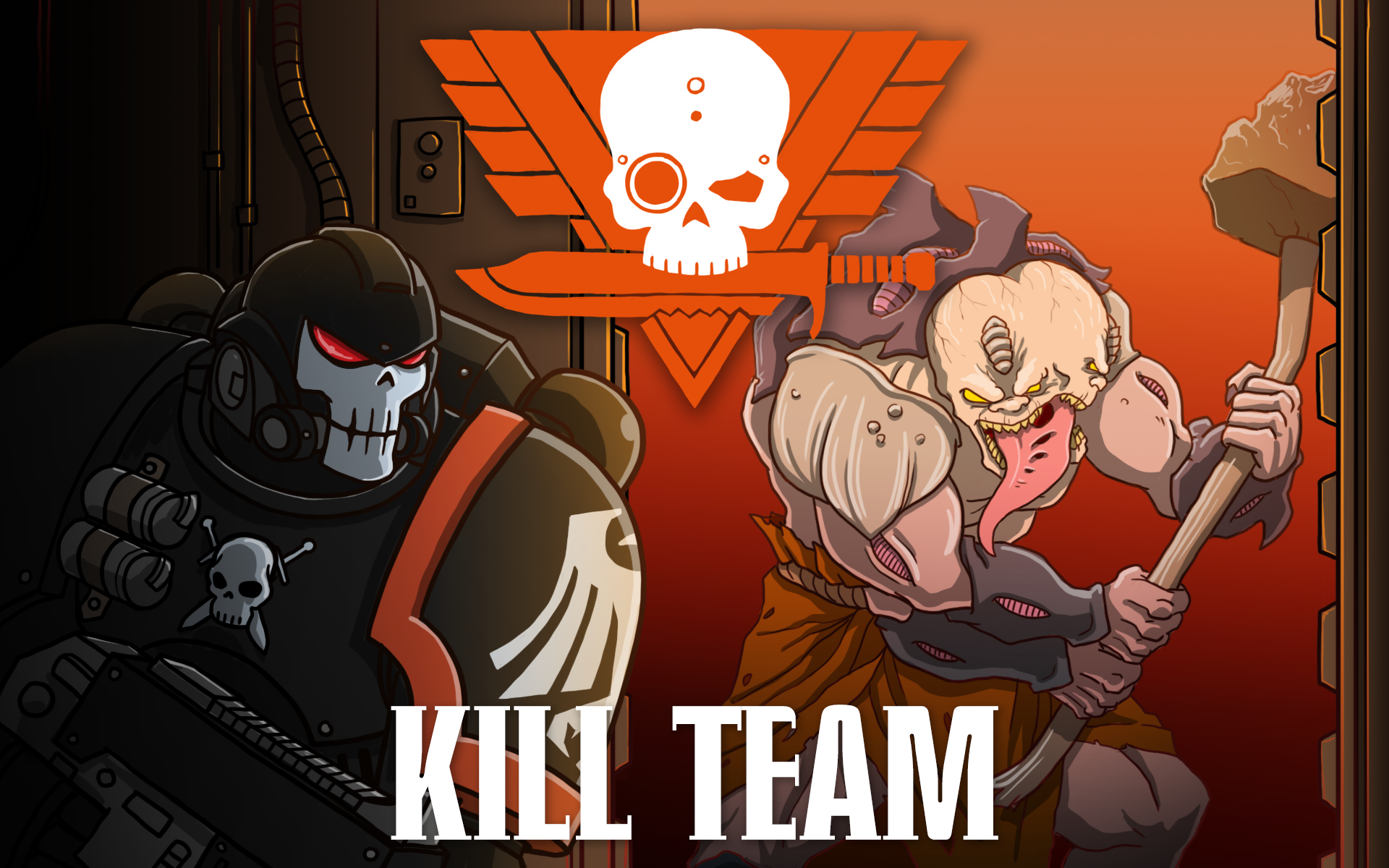
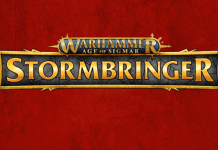
![[40k] Competitive Innovations in 10th: Death Beckons pt.2](https://d1w82usnq70pt2.cloudfront.net/wp-content/uploads/2020/01/Analysis_Banner.png)

